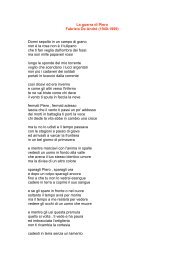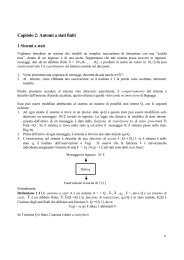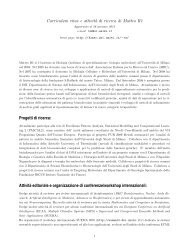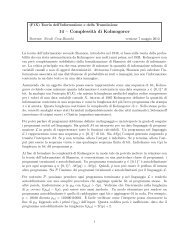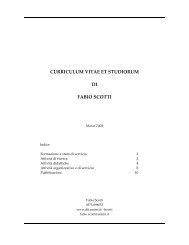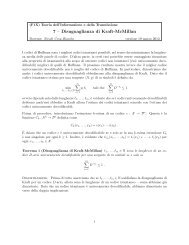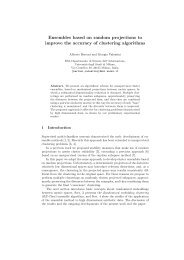Detecting self-mutating malware using control-flow graph matching
Detecting self-mutating malware using control-flow graph matching
Detecting self-mutating malware using control-flow graph matching
Create successful ePaper yourself
Turn your PDF publications into a flip-book with our unique Google optimized e-Paper software.
<strong>Detecting</strong> <strong>self</strong>-<strong>mutating</strong> <strong>malware</strong> <strong>using</strong><br />
<strong>control</strong>-<strong>flow</strong> <strong>graph</strong> <strong>matching</strong><br />
Danilo Bruschi, Lorenzo Martignoni, and Mattia Monga<br />
Dip. Informatica e Comunicazione<br />
Università degli Studi di Milano<br />
Via Comelico 35, I-20135 Milan, Italy<br />
{bruschi,martign,monga}@dico.unimi.it<br />
Abstract. Next generation <strong>malware</strong> will by be characterized by the<br />
intense use of polymorphic and metamorphic techniques aimed at circumventing<br />
the current <strong>malware</strong> detectors, based on pattern <strong>matching</strong>.<br />
In order to deal with this new kind of threat novel techniques have to be<br />
devised for the realization of <strong>malware</strong> detectors. Recent papers started<br />
to address such issue and this paper represents a further contribution in<br />
such a field. More precisely in this paper we propose a strategy for the<br />
detection of malicious codes that adopt the most evolved <strong>self</strong>-mutation<br />
techniques; we also provide experimental data supporting the validity of<br />
such a strategy.<br />
1 Introduction<br />
Malware detection is normally performed by pattern <strong>matching</strong>. Detectors have a<br />
database of distinctive patterns (the signatures) of malicious pieces of code and<br />
they look for that in possibly infected systems. This approach is fast and, up to<br />
now, quite effective when it is used to find known viruses.<br />
Such defences will probably be circumvented by the next generation malicious<br />
code which will intensively make use of metamorphism. This type of <strong>malware</strong><br />
is not yet appeared in the wild, but some prototypes have been implemented<br />
(see for example MetaPHOR [2], Zmist [12], Evol) which have shown the<br />
feasability and the efficacy of mutation techniques [18]. Some papers recently<br />
appeared in literature [8, 7], have shown that current commercial virus scanners<br />
can be easily circumvented by the use of simple mutation techniques.<br />
Various levels of code mutation have been individuated in literature, ranging<br />
from simple modifications (e.g. useless instructions insertion, and registers<br />
swapping) to the complete mutation of the payload. Probably the most advanced<br />
prototype in such a context is represented by the Zmist virus, which beside a<br />
metamorphic engine which takes care of changing the static structure of the payload,<br />
inserts it<strong>self</strong> into an executable code and scatters its body among the benign<br />
instructions (that are updated to reflect relocations). Malicious fragments are<br />
then connected together <strong>using</strong> appropriate <strong>control</strong> <strong>flow</strong> transition instructions.<br />
The malicious code will be executed when the normal <strong>control</strong> <strong>flow</strong> reaches its<br />
first instruction: this is known as Entry Point Obfuscation [4]. Threats such as
those represented by the Zmist virus, poses three serious challenges to <strong>malware</strong><br />
detectors:<br />
– the ability to recognize <strong>self</strong>-<strong>mutating</strong> code code;<br />
– the ability to recognize <strong>malware</strong> which is randomly spread in the original<br />
code;<br />
– the ability to recognize code which does not modify neither the behavior nor<br />
the properties of the infected program.<br />
Note also that in order to be effective a <strong>malware</strong> detector has to be able to solve<br />
the above challenges simultaneously.<br />
The only viable way for dealing with such a kind of threat is the construction<br />
of detectors which are able to recognize <strong>malware</strong>’s dynamic behavior instead of<br />
some static properties (e.g. fixed byte sequences or strangeness in the executable<br />
header). Recent papers ([9, 7, 14, 17]) started to address such issues and this<br />
paper represents a further contribution in such a field. More precisely in this<br />
paper we propose a strategy for solving the problems above mentioned, and<br />
we will also provide experimental data which indicate that such a strategy can<br />
represent a significant step towards the identification of novel techniques for<br />
dealing with the new forms of <strong>malware</strong>.<br />
Roughly speaking the strategy we propose works as follows. Given an executable<br />
program P we perform on it a disassembling phase which produces a<br />
program P ′ , on P ′ we perform a normalization phase aimed at reducing the<br />
effects of most of the well known mutations techniques and at unveiling the<br />
<strong>flow</strong> connection between the benign and the malicious code, thus obtaining a<br />
new version of P namely PN. Subsequently given PN we build its corresponding<br />
labelled inter-procedural <strong>control</strong> <strong>flow</strong> <strong>graph</strong> CF GPN which will be compared<br />
against the <strong>control</strong> <strong>flow</strong> <strong>graph</strong> of a normalized <strong>malware</strong> CF GM in order to verify<br />
whether CF GPN contains a sub<strong>graph</strong> which is isomorphic to CF GM , thus<br />
reducing the problem of detecting a <strong>malware</strong> inside an executable, to the sub<strong>graph</strong><br />
isomorphism problem1 . Using such a strategy we will be able to defeat<br />
most of the mutations techniques (see also [5] for further details) adopted for<br />
the construction of polymorphic <strong>malware</strong> as well as code scattering. Obviously,<br />
the strategy still need improvements, but the experimental results we obtained<br />
are really encouraging.<br />
The paper is organized as follows. Section 2 describes some of the techniques<br />
that can be adopted by a <strong>malware</strong> to accommodate its payload within a benign<br />
program stealthily. In Section 3 we describe the approach we followed in order to<br />
treat the kind of malicious code. Section 4 briefly describes how our prototype<br />
was realized and discusses the experimental results obtained. Section 5 discussed<br />
related works and in the last section we draw our conclusion about the work<br />
presented.<br />
1 The sub<strong>graph</strong> isomorphism problem is a well known NP-complete problem, but in<br />
most of the instances we will consider it turns out to be tractable in an efficient way.
2 Concealing malicious code<br />
In order to assess our approach, we experimented with a simulated <strong>malware</strong> that<br />
is able to insert its own payload (the guest) into another executable (the host).<br />
Our mock virus can inject its code in ELF executables, and it uses only basic<br />
modifications of the host code to accommodate the guest. The basic technique<br />
consists in localizing existing candidate insertion points. Moreover, new insertion<br />
points are added while guaranteeing that the host code continue to run mostly as<br />
in the past. The entry point of the guest is located somewhere in the executable<br />
code but its never referenced directly (in fact it is possible that it is never<br />
reached, and consequently, never executed), thus achieving complete entry point<br />
obfuscation. There are many different ways to perform code insertion and entry<br />
point obfuscation but we decided to analyze deeply only three of them, in order<br />
to keep our prototype simple enough, while being able to demonstrate that<br />
complete insertion, whose identification and reversal is not obvious, is possible.<br />
A brief description of the techniques used by our prototype (which targets<br />
GNU/Linux IA-32 Elf executables) to achieve stealthiness follows.<br />
2.1 Unused space between subsequent functions<br />
The first technique we consider exploits a behaviour of most compilers which<br />
usually between a function epilogue and the next one prologue add some padding<br />
filled with NOPs. It is easy to find this unused space by trivial pattern <strong>matching</strong>:<br />
we used two different patterns: (i) \x90{7,} (i.e., more than 7 consecutive nop)<br />
and (ii) \xc3\x90{7,} (i.e. ret followed by more than 7 consecutive nops). The<br />
former is used to identify any type holes that do may accommodate a malicious<br />
code; the latter is used to identify holes that start just after the epilogue and<br />
that can potentially be reached by an execution <strong>flow</strong> 2 . Any hole of type (ii) can<br />
be used as the guest entry point by moving the ret instruction at the end of the<br />
nops padding and substituting nops with payload operations. (Figure 1 shows<br />
this kind of insertion). Holes of type (i) can also be used to insert arbitrary code,<br />
but this code must be reached by a <strong>control</strong> <strong>flow</strong> starting from an entry point<br />
created somewhere else, otherwise it will never be executed. This technique is<br />
known as cavity insertion [4].<br />
During our experiments we discovered that insertion points of type (i) are<br />
pretty common (several occurrences per binary program), while insertion points<br />
of type (ii) are rather rare, although we found at least a candidate in virtually<br />
all the binaries we examined.<br />
2.2 Manipulation of jump tables<br />
Another technique we implemented for realizing entry point obfuscation is the<br />
jump-table manipulation. A jump-table is commonly used by compilers to im-<br />
2 This pattern does not correspond to a standard epilogue (i.e., leave; ret) because<br />
in several cases the leave instruction is substituted with some direct operations on<br />
the stack.
mov %ebp,%esp<br />
pop %ebp<br />
ret<br />
nop<br />
nop<br />
...<br />
nop<br />
nop<br />
push %ebp<br />
mov %esp,%ebp<br />
mov %ebp,%esp<br />
pop %ebp<br />
payload<br />
payload<br />
...<br />
payload<br />
payload<br />
ret<br />
push %ebp<br />
mov %esp,%ebp<br />
Fig. 1. Insertion of the guest payload between two function boundaries<br />
plement switch-like constructs. The right block of instructions is addressed by<br />
an indirect jump through the table, which is stored in an appropriate section of<br />
ELF executables, namely the .rodata section.<br />
Jump tables can be exploited to inject malicious code in two conceptually<br />
analogous ways: (i) by replacing an entry with an address in which the new<br />
payload has been inserted and then link back the payload to the original target<br />
address or (ii) by moving a block of instructions addressed by an entry to a new<br />
location, while <strong>using</strong> the room just freed for the payload, augmented with a final<br />
jump to the original code.<br />
We look for jump tables in executables by pattern <strong>matching</strong> in the text segment:<br />
we looked for \x24\xff\d(addr) (e.g. jmp *addr(,%reg,4)) where addr,<br />
or even simply \d{4}, must be an address belonging to the .rodata section. Once<br />
the absolute address of the jump table has been found, target addresses can be<br />
located just by extracting values starting from the beginning of the jump table<br />
and stopping when a value does not represent a valid text segment address.<br />
2.3 Data segment expansion<br />
The last technique we considered is based on creation of an hole in the data<br />
segment, hole which can then be used for any kind of purposes as the benign<br />
code is not aware of its presence and instructions in this segment can be normally<br />
executed on my architectures. In the following a brief description of such a<br />
technique is provided.<br />
Figure 2 depicts the simplified layout of an ELF executable; the left picture<br />
shows the layout of the file while the one on the right shows the layout once the<br />
executable is loaded in memory; the text segment is depicted in white while the<br />
data segment in gray. The data segment of an executable is divided in several<br />
sections, the most important ones are .data and .bss. The former is used to<br />
hold initialized data and it is loaded from the executable file while the latter<br />
holds uninitialized data and has no file counterpart.<br />
Since the .bss section is neither initialized nor stored on the file, it can be<br />
easily shifted in order to increase the space available for the .data section which<br />
always precedes .bss. Such a modification however would require that all the
.text<br />
.rodata<br />
.data<br />
.text<br />
.rodata<br />
.data<br />
.bss<br />
Fig. 2. Simplified layout of an executable.<br />
instructions that reference the .bss section being updated. In order to avoid such<br />
an operation, an empty space of the same size of the original .bss is preserved<br />
in the expanded .data, and a new .bss section is mapped into a higher set of<br />
addresses. In such a way the code continues to refer to the old .bss section (see<br />
Figure 3). The new .bss and the hole created in .data can instead be used by<br />
the guest code for any kind of purpose.<br />
.text .text<br />
.rodata<br />
.data<br />
.bss (old)<br />
.data<br />
.rodata<br />
.data<br />
.bss (old)<br />
.data<br />
Fig. 3. Simplified layout of a manipulated executable with an expanded .data<br />
3 Unveiling malicious code<br />
The techniques described in the previous Section make <strong>malware</strong> detection rather<br />
problematic with respect to current anti-virus technology ([8, 7] witnessed the<br />
problem experimentally). In fact:<br />
– pattern <strong>matching</strong> fails, since fragmentation and mutation make hard to find<br />
signature patterns;<br />
.bss
– emulation would require a complete tracing of analyzed programs because<br />
the entry point of the guest is not known. Moreover every execution should<br />
be traced until the malicious payload is not executed;<br />
– even heuristics based on predictable and observable alterations of executables<br />
could become useless when insertion is performed producing almost no<br />
alteration of any of the static properties of the original binary.<br />
The core of the problem is that the malicious code seamlessly becomes part<br />
of the host program, thus making very difficult to distinguish between the two.<br />
In order to find out <strong>malware</strong> code we have to deal with both mutations and<br />
scattering.<br />
As far as mutation is concerned, we aim at normalizing different instances<br />
of the same malicious code into a canonical and minimal version. Our previous<br />
experiments [5] showed that, by exploiting well known techniques of code<br />
optimization, it is possible to revert most of the mutations commonly used by<br />
<strong>malware</strong>. However, the lack of an easily guessable entry point makes things much<br />
more complicated. In fact, the detection can not be restricted to a limited set of<br />
instructions to check whether they can be considered equivalent (up to an acceptable<br />
threshold of accuracy) to <strong>malware</strong> code. The detection must consider every<br />
instruction in order to analyze if some groups of them, logically connected but<br />
physically separated by malicious scattering, match with the canonical version<br />
of <strong>malware</strong> under analysis.<br />
In order to perform such tasks we devised a detection process which is composed<br />
by two different components: the code normalizer and the code comparator.<br />
The following sections describe them in details.<br />
3.1 Code normalizer<br />
The goal of the code normalizer is to normalize a program, i.e. transform it<br />
into a canonical form which is simpler in term of structure or syntax while preserving<br />
the original semantic. Most of the transformations used by <strong>malware</strong> to<br />
dissimulate their presence led to unoptimized versions of its archetype 3 , since<br />
they contain some irrelevant computations whose presence has the only goal of<br />
hurdling recognition. Normalization aims at removing all the trash code introduced<br />
during the mutation process and thus can be viewed as an optimization<br />
of their code.<br />
Decoding The executable machine code P is translated into a new representation<br />
P ′ that allows to describe every machine instruction in term of the operations<br />
it performs on the cpu. The goal is to increase, as much as possible, the<br />
level of abstraction and to express the program in a form that is more suitable<br />
for deeper analyses. P ′ will be the standard input to all the subsequent phases.<br />
3 The term archetype is used to describe the zero-form of a <strong>malware</strong>, i.e., the original<br />
and un-mutated version of the program from which other instances are derived.
Control-<strong>flow</strong> and Data-<strong>flow</strong> analysis Control-<strong>flow</strong> analysis detects <strong>control</strong><br />
<strong>flow</strong> dependencies among different instructions, such as dominance relations,<br />
loops, and recursive procedure calls. Data-<strong>flow</strong> analysis collects information<br />
about data relationship among program instructions. Particularly, all the definitions<br />
which can possibly reach each program instruction and all the definitions<br />
that are live before and after each instruction.<br />
Code transformation Information collected through <strong>control</strong>-<strong>flow</strong> and data<strong>flow</strong><br />
analysis are used to identify which kind of transformations can be applied at<br />
any program point, in order to reduce it to the normal form. The transformation<br />
that can be successfully used to achieve our goal are compiler optimizations that<br />
are particularly suited for the reduction of the size of the code [3, 16], which,<br />
although developed to be used on source code, they have been showed to be<br />
suited also for machine executable code [11].<br />
More practically, normalization allows to:<br />
– identifying all the instructions that do not contribute to the computation<br />
(dead and unreachable code elimination);<br />
– rewriting and simplifying algebraic expressions in order to statically evaluate<br />
most of their sub-expressions that can be often removed;<br />
– propagating values assigned or computed by intermediate instructions, and<br />
assigned to intermediate variables into the instructions that make use of these<br />
values in order to get rid of the intermediate variables previously needed only<br />
for their temporary storage (constant and expression propagation);<br />
– analyze and try to evaluate <strong>control</strong> <strong>flow</strong> transition conditions to identify<br />
tautologies, and rearrange the <strong>control</strong> <strong>flow</strong> removing dead paths;<br />
– analyze indirect <strong>control</strong> <strong>flow</strong> transitions to discover the smallest set of valid<br />
targets and the paths originating. It is worth nothing that the connections<br />
between the benign and the malicious code are concealed behind these layers<br />
of indirections.<br />
Although the analysis involves every program instructions, we expect that<br />
most of the candidate transformation targets are those that belong to the malicious<br />
code since host programs are usually already optimized during compilation.<br />
Limitations of static analysis As just mentioned, more accurate the code normalizer<br />
is, major are the chances of recognizing a given <strong>malware</strong>. Unfortunately<br />
there exist transformations that can be very difficult to revert and situations in<br />
which normalization can not be performed on the entire code.<br />
The use of opaque predicates [10] during the mutation can complicate the detection<br />
because the code produced, once normalized, may have different shapes.<br />
A predicate is defined opaque if its value is known a priori during obfuscation<br />
but it is difficult to deduce statically after obfuscation has been applied. Opaque<br />
predicates, which are generally used in code obfuscation and watermarking, allow<br />
to distort the <strong>control</strong> <strong>flow</strong> <strong>graph</strong>s inserting new paths that will not be removed
during normalization unless the predicate can be evaluated, and the evaluation<br />
usually is very expensive or unfeasible.<br />
The adoption of anti-analysis techniques by the <strong>malware</strong>, is a further problem<br />
for <strong>malware</strong> detection. Within this category fall anti-disassembling techniques<br />
[15] which can be employed to prevent a precise decoding of programs.<br />
We voluntarily neglected this problem because we assumed that <strong>self</strong>-<strong>mutating</strong><br />
malicious codes need to be able to analyze their own code in order to generate<br />
the new one, thus they must be able to decode themselves and if they can, at<br />
least a decoder must exist.<br />
The presence of indirection (where by indirection we mean a <strong>control</strong> <strong>flow</strong><br />
transition that reference the target through a variable), in the analyzed code,<br />
could lead to an incomplete exploration of the code it<strong>self</strong>. In such a case if the<br />
malicious code, or at least its entry point, resides in the unexplored region, the<br />
corresponding <strong>control</strong> <strong>flow</strong> <strong>graph</strong> will not be complete and the presence of the<br />
malicious code will never be detected. The data-<strong>flow</strong> analysis performed during<br />
normalization plays a fundamental role in the resolution of indirections but it<br />
may miss to solve some of them; some heuristics could be adopted in order to<br />
exhaustively identify code regions and explore them.<br />
Notwithstanding these limitations our experiments (see [5]) showed that normalization<br />
can be used effectively in most of the cases.<br />
3.2 Code comparator<br />
Given a program P and a malicious code M as input the code comparator<br />
answers to the following question: is the program P hosting the <strong>malware</strong> M? or<br />
more precisely, is an instance of M present inside P ? The code comparator does<br />
not work directly on the native representation of the two inputs but instead it<br />
works on the normalized form P , namely PN. Obviously we cannot expect to<br />
find, a perfect <strong>matching</strong> of M in PN, as M is <strong>self</strong>-<strong>mutating</strong>, and even if most<br />
of the mutations it suffered have been removed through the code normalizer, we<br />
expect that some of them remain undiscovered. Therefore, the code comparator<br />
must be able to cope with most of these differences, which we observed are<br />
normally local to each basic block 4 . As a consequence, the basic <strong>control</strong> <strong>flow</strong><br />
structure (as results from normalization) is in general preserved by mutations.<br />
Thus, we decided to represent the malicious code and the alleged host program<br />
by their inter-procedural <strong>control</strong> <strong>flow</strong> <strong>graph</strong>s. A <strong>control</strong> <strong>flow</strong> <strong>graph</strong> (CFG)<br />
is an abstract representation of a procedure: each node in the <strong>graph</strong> represents a<br />
basic block, i.e. a straight-line piece of code without any jumps or jump targets;<br />
jump targets start a block and jumps end a block. Directed edges are used to<br />
represent jumps in the <strong>control</strong> <strong>flow</strong>. An inter-procedural CFG links together the<br />
CFGs of every function of a program.<br />
Under this assumption, the search for malicious code can be formulated as<br />
a sub<strong>graph</strong> isomorphism decision problem: given two <strong>graph</strong>s G1 and G2, is G1<br />
4 A basic block is a sequence of instructions in which every of them always executes<br />
before all the subsequent ones.
isomorphic to a sub<strong>graph</strong> of G2? Fig. 4 shows the two <strong>graph</strong>s just mentioned:<br />
the first one models the searched malicious code and the second one the program<br />
which is going to be analysed in order to verify if it is hosting the malicious code.<br />
We briefly recall that sub-<strong>graph</strong> isomorphism is an NP-complete problem in the<br />
general case, but in our particular case, characterized by highly sparse <strong>graph</strong>s,<br />
it turned out to be computable in a very efficient way.<br />
Fig. 4. The <strong>graph</strong>s representing a malicious code M and a generic normalized program<br />
PN . The nodes highlighted in gray are those of PN program <strong>matching</strong> the ones of M.<br />
As comparison through raw inter-procedural <strong>control</strong> <strong>flow</strong> <strong>graph</strong>s is too coarse<br />
we decided to augment these <strong>graph</strong>s labelling both nodes and edges: nodes are<br />
labelled according to the properties of the instructions belonging to them and<br />
edges are labelled according to the type of the <strong>flow</strong> relations between the nodes<br />
they connect. The labelling method we decided to adopt is very similar to the<br />
one proposed in [14]. Instructions, similar from the semantic point of view, are<br />
grouped together into classes and the label assigned to each node is a number that<br />
represents the set of classes in which, instructions of the node, can be grouped.<br />
Edges are labelled in the same way: possible <strong>flow</strong> transitions are grouped into<br />
classes according to the type of each transition. Table 1 shows the classes in<br />
which we decided to group instructions and <strong>flow</strong> transitions. Calls to shared<br />
library functions are also represented with the same notation: the caller node is<br />
connected to the function that is represented with just one node and which is<br />
labelled with a hash calculated starting from the function name.<br />
It is important to note that the normalization allows reduce the number of<br />
possible classes because assembly instructions are converted into the intermediate<br />
representation which explicitly describes each instruction in term of the<br />
actions it performs on the CPU. Instructions like push and pop do not require a<br />
dedicated class because they are translated in assignment and integer arithmetic<br />
instructions.
Instruction classes<br />
Integer arithmetic<br />
Float arithmetic<br />
Logic<br />
Comparison<br />
Function call<br />
Indirect function call<br />
Branch<br />
Jump<br />
Indirect jump<br />
Function return<br />
Flow transition classes<br />
One-way<br />
Two-way<br />
Two-way (fallback or false)<br />
N-way (computed targets of<br />
indirect jumps or calls)<br />
Table 1. Instructions and <strong>flow</strong> transition classes.<br />
The comparison method gracefully handles malicious code fragments scattered<br />
anywhere, no matter where they are located, on condition that it is possible<br />
to find out the connections existing among them. That is possible because,<br />
for the way in which the problem has been formulated, no information about the<br />
physical location of the fragments and about the properties of these locations are<br />
considered. For example, a malicious code that, during execution, jumps from<br />
the text to the data segment, and vice versa, or that jumps across different<br />
functions is treated as exactly one that would jump to an adjacent memory address.<br />
It is a code normalizer duty to unveil the connections existing among the<br />
fragments composing the <strong>malware</strong>.<br />
4 Prototype implementation and experimental results<br />
A prototype has been built in order to verify experimentally our idea both in<br />
terms of correctness but also in terms of efficiency. We build our code normalization<br />
on top of Boomerang [1], which is an open source decompiler which<br />
reconstructs high-level code starting from binary executables. Boomerang allowed<br />
us to perform the data-<strong>flow</strong> and <strong>control</strong>-<strong>flow</strong> analysis directly on machine<br />
code. We adapted it in order to better handle the set of transformations, previously<br />
described, needed for removing the mutations and bring a <strong>malware</strong> back to<br />
its original form. The set of transformations to apply to a code are decided on the<br />
basis of the results of <strong>control</strong> and data <strong>flow</strong> analysis. The analysis framework we<br />
considered is also capable of accommodating the resolution of indirections and<br />
to perform jump-table and call-table analysis.<br />
Once the transformations above described are performed on an executable,<br />
a labelled <strong>control</strong> <strong>flow</strong> of the resulting code is built and it is fed, along with the<br />
<strong>control</strong> <strong>flow</strong> of a <strong>malware</strong>, to a sub-<strong>graph</strong> isomorphism algorithm in order to<br />
perform the detection phase. For such a task we referred to the VF2 algorithm<br />
contained in the VFlib [13] library.
4.1 Code normalization evaluation<br />
The effectiveness of code normalization was evaluated in [5] by <strong>using</strong> the MetaPHOR [2]<br />
virus. A big set of virus samples, about 115, was normalized in order to compare<br />
the original form with the new one. We observed that the effectiveness of the<br />
approach has been confirmed by the fact that all the samples assumed the same<br />
shape and that their labelled <strong>control</strong> <strong>flow</strong> <strong>graph</strong>s can be considered isomorphic.<br />
As all possible kind of transformations have been successfully applied during<br />
the samples normalization, we believe that the same encouraging results can be<br />
obtained when the same approach is used in order to discover the link between<br />
the host code and the malicious code entry point because it camouflaged in the<br />
same way in which links among malicious code fragments are.<br />
A measure of the time efficiency of this step of the detection process has been<br />
performed. It turned out that the time required to normalize small fragments<br />
of code composed by few functions, and noticed that the time ranges from 0.2<br />
secs. to 4.4 secs. This data indicates that such a phase will probably be very<br />
time consuming with big executables.<br />
4.2 Code comparison evaluation<br />
In order to evaluate the correctness of our approach we performed a set of experimental<br />
tests on a huge set of system binary executables. The executables have<br />
been picked up from a GNU/Linux distribution. Subsequently they have been<br />
processed in order to construct their inter-procedural augmented <strong>control</strong> <strong>flow</strong><br />
<strong>graph</strong>s, from whom the <strong>graph</strong>s associated to each program function have been<br />
generated; duplicated functions have been thrown away 5 . During our preliminary<br />
experiments we noticed that small <strong>graph</strong>s (4 or less) are not suited to describe<br />
unambiguously some particular code fragments. For this reason we decided to<br />
throw away from our sample set all <strong>graph</strong>s with 5 or less nodes. Functions, or<br />
standalone code fragments, with such a small number of nodes cannot represent<br />
a computation that, from the detection point of view, can be considered<br />
“typical”. Table 2 summarized the characteristics of our sample.<br />
Type #<br />
Executables 572<br />
Functions (with more then 5 nodes) 25145<br />
Unique functions (with more then 5 nodes) 15429<br />
Table 2. Sample set used during our experiments.<br />
The unique functions (functions found in more then one executable were used<br />
only once) identified were used to simulate malicious codes and we look for their<br />
5 Two functions are considered equivalent if the MD5s, computed on the strings built<br />
<strong>using</strong> the first byte of any machine instruction composing their code, match.
occurrences within the programs of the sample set <strong>using</strong> our code comparator<br />
module. The code comparator reported 55606 matches. In order to evaluate<br />
the correctness of such a data we compared it against the results returned by<br />
comparing the fingerprints of the considered codes. Note that the fingerprinting<br />
method produces almost no false positive, while it can have false negative. It<br />
turned out that 96.5% (53635) of the matches found, were confirmed also by the<br />
fingerprint method. The two methods instead disagree on the remaining 3.5%<br />
(1971) of the samples, for our comparator these were instances of the simulated<br />
malicious code while this was not true for the fingerprinting method. As in such<br />
a case even the fingerprinting method can be wrong we deepen our analysis, in<br />
order to have a better estimate of the false positive ratio of our code comparator.<br />
For this reason we randomly chosen, among the subset of the sample on which<br />
the two method disagreed, a set E of 50 potentially equivalent pairs of code<br />
fragments and inspected them manually. The same was done with a set NE of<br />
50 potentially different pairs of code fragments. The results of our evaluation<br />
are reported in Table 3. With the exception made for a few cases, involving<br />
rather small <strong>graph</strong>s, it turned out that our code comparator was correct in<br />
determining the equivalence of members of E. Some code fragments required a<br />
thorough analysis because of some differences local to the nodes of the <strong>graph</strong>s<br />
(probably the same code compiled in different moment) that, after all, turned<br />
out to be equivalent. Other few cases highlighted a bug in the routine that<br />
performs labelling 6 and another case involved two enormous <strong>graph</strong>s there were<br />
not possible to compare by hand. With respect to the member in NE all the<br />
results of the code comparator were confirmed by the manual inspection.<br />
Positive results # %<br />
Equivalent code 35 70<br />
Equivalent code<br />
(negligible differences) 9 18<br />
Different code<br />
(small number of nodes) 3 6<br />
Unknown 1 2<br />
Bug 2 4<br />
Negative results # %<br />
Different code 50 100<br />
Table 3. Manual evaluation of a random subset of the results returned by the code<br />
comparator.<br />
Even if sub-<strong>graph</strong> isomorphism is an NP-complete problem in the case of<br />
general <strong>graph</strong>s, the particular instances of <strong>graph</strong>s we are dealing with make it well<br />
tractable. A generic inter-procedural <strong>control</strong> <strong>flow</strong> <strong>graph</strong> has a huge number of<br />
6 The prototype was not able to find out the name of two shared library functions,<br />
assumed they were unknown and considered them equivalent. The two codes that,<br />
apart from the different functions called were equivalent, were erroneously considered<br />
equivalent.
nodes but it is highly sparse, in fact the average density we measured (measured<br />
as |E|/|N| 2 , where E is the set of edges and N the set of nodes) was about<br />
0.0088.<br />
In order to verify this assumption we measured the time requested to perform<br />
the <strong>matching</strong>. We decided to distinguish between: (i) average time required to<br />
load a <strong>graph</strong> measured with respect to the number of nodes in the <strong>graph</strong> and<br />
(ii) worst cases time required to perform a complete search within the <strong>graph</strong><br />
representing host programs under verification (no distinction has been made<br />
between positive and negative matches). These measures, collected through a<br />
GNU/Linux system with a IA-32 1GHz processor, are reported in Fig. 4. In<br />
particular, the data provided shows that the critical phase of the entire procedure<br />
is not related to the computation time but instead to the initialization of the<br />
requested data structures. A quick glance at the code of the library used to<br />
perform the <strong>matching</strong> highlighted that when a <strong>graph</strong> is loaded, internal data<br />
structures are filled in O(n 2 ) (n stands for the number of nodes) but we believe<br />
that the same goal can be achieved in O(n).<br />
# nodes Average load time Worst detection time<br />
(secs.) (secs.)<br />
0 - 100 0.00 0.00<br />
100 - 1000 0.09 0.00<br />
1000 - 5000 1.40 0.05<br />
5000 - 10000 5.15 0.14<br />
10000 - 15000 11.50 0.32<br />
15000 - 20000 28.38 0.72<br />
20000 - 25000 40.07 0.95<br />
25000 - 50000 215.10 5.85<br />
Table 4. Summary of the measured average load time and of the worst detection time<br />
with regards to the number of nodes.<br />
5 Related works<br />
The problem of the detection of <strong>mutating</strong> <strong>malware</strong> is not new and the first theoretical<br />
studies about the problem [6] have posed serious worryings demonstrating<br />
that there could exist <strong>malware</strong> which no algorithm can detect. Some paper appeared<br />
recently in the literature started to pragmatically address the problem<br />
of the detection of evolved malicious code with <strong>mutating</strong> capabilities. Different<br />
approaches have been proposed in order to target specific types of <strong>malware</strong> and<br />
specific propagation methods.<br />
The first work which addressed the problem of the detection of obfuscating<br />
<strong>malware</strong> through static analysis was done by Christodorescu and Jha [7] which<br />
has been refined in [9]. In their first work annotation of program instructions has<br />
been used in order to provide an abstraction from the machine code and to detect
common patterns of obfuscation; malicious codes were then searched directly on<br />
the annotated code. In their second work deobfuscation through annotation has<br />
been replaced by a more sophisticated set of complementary techniques that<br />
are used in concomitance to corroborate the results. The techniques adopted<br />
provide different levels of resilience to mutation and ranges from the detection<br />
of previously known mutated patterns to the proof of instructions sequences<br />
equivalence through the use of theorem prover and random execution. Our work<br />
shares the same goals but adopts a different strategy which consists in the most<br />
complete defection of mutations through normalization.<br />
Poly<strong>graph</strong> [17] targets polymorphic worms and is capable of automatically<br />
determining appropriate signatures. Signatures are generated starting from network<br />
streams and consist of multiple disjoint content substrings which are supposed<br />
to be shared among different instances; these invariant substrings consists<br />
of protocol framing, return addresses, and poorly obfuscated code.<br />
In [14] an algorithm for the detection of unknown polymorphic worms is presented.<br />
The algorithm compares the similarity of apparently independent network<br />
streams in order to discover if they are carrying the same malicious code.<br />
Each network stream is processed in order to identify potential executable code<br />
by trying to disassemble each stream and to generate the appropriate <strong>control</strong><br />
<strong>flow</strong> <strong>graph</strong> which is then divided in little sub-<strong>graph</strong>s in order to fingerprints the<br />
stream. Our comparison method share some similarities with the one proposed<br />
in the paper: we also represent executables code trough labelled <strong>control</strong> <strong>flow</strong><br />
<strong>graph</strong>s (we work with them in their entirety) but we adopted different comparison<br />
strategies and performed normalization because we treated a different type<br />
of malicious codes that adopt more sophisticated anti-detection techniques. We<br />
believe that the normalization techniques we have proposed can be used to improve<br />
the detection power making the system no more susceptible to <strong>malware</strong><br />
that could adopt more sophisticated mutations.<br />
6 Conclusions and future works<br />
Despite theoretical studies demonstrated that there could exist an undetectable<br />
malicious code we have given our contribution in demonstrating that the techniques<br />
currently adopted by malicious code writer in order to achieve perfect<br />
mutation do not allow to get so close to the theoretical limit.<br />
We analyzed the type of transformations adopted to implement <strong>self</strong>-<strong>mutating</strong><br />
<strong>malware</strong> in order to avoid detection and we convinced ourselves that the only<br />
viable way for dealing with such a kind of threat is the construction of detectors<br />
which are able to characterize the dynamic behavior of the <strong>malware</strong>.<br />
We have proposed a pragmatical approach that is able to cope quite well<br />
with this treat which is based on (i) the defection of the mutation process and<br />
(ii) the analysis of a program in order to verify the presence of the searched<br />
malicious code. Mutation process is reverted through code normalization and the<br />
problem of detecting <strong>malware</strong> inside an executable is reduced to the sub<strong>graph</strong>
isomorphism problem: a well known NP-complete problem that nevertheless can<br />
be efficiently computed when sparse <strong>graph</strong>s are concerned.<br />
We believe that experimental results are encouraging and we are working on<br />
refining our prototype in order to validate it in more real scenarios.<br />
References<br />
1. Boomerang. http://boomerang.sourceforge.net.<br />
2. MetaPHOR. http://securityresponse.symantec.com/avcenter/venc/data/<br />
w32.simile.html.<br />
3. A. V. Aho, R. Sethi, and J. D. Ullman. Compilers: Principles, Techniques and<br />
Tools. Addison-Wesley, 1986.<br />
4. C. Associates. Security advisor center glossary. http://www3.ca.com/<br />
securityadvisor/glossary.aspx.<br />
5. D. Bruschi, L. Martignoni, and M. Monga. Using code normalization for fighting<br />
<strong>self</strong>-<strong>mutating</strong> <strong>malware</strong>. In To be presented at ISSSE06.<br />
6. D. M. Chess and S. R. White. An undetectable computer virus. In Proceedings of<br />
Virus Bulletin Conference, Sept. 2000.<br />
7. M. Christodorescu and S. Jha. Static analysis of executables to detect malicious<br />
patterns. In Proceedings of USENIX Security Symposium, Aug. 2003.<br />
8. M. Christodorescu and S. Jha. Testing <strong>malware</strong> detectors. In Proceedings of the<br />
2004 ACM SIGSOFT International Symposium on Software Testing and Analysis<br />
(ISSTA 2004), pages 34–44, Boston, MA, USA, July 2004. ACM Press.<br />
9. M. Christodorescu, S. Jha, S. A. Seshia, D. Song, and R. E. Bryant. Semanticsaware<br />
<strong>malware</strong> detection. In Proceedings of the 2005 IEEE Symposium on Security<br />
and Privacy (Oakland 2005), Oakland, CA, USA, May 2005.<br />
10. C. Collberg, C. Thomborson, and D. Low. A taxonomy of obfuscating transformations.<br />
Technical Report 148, Department of Computer Science, University of<br />
Auckland, July 1997.<br />
11. S. K. Debray, W. Evans, R. Muth, and B. D. Sutter. Compiler techniques for code<br />
compaction. ACM Trans. Program. Lang. Syst., 22(2):378–415, 2000.<br />
12. P. Ferrie and P. Ször. Zmist opportunities. Virus Bullettin, 2001.<br />
13. P. Foggia. The VFLib <strong>graph</strong> <strong>matching</strong> library, version 2.0. http://amalfi.dis.<br />
unina.it/<strong>graph</strong>/db/vflib-2.0/.<br />
14. C. Kruegel, E. Kirda, D. Mutz, W. Robertson, and G. Vigna. Polymorphic worm<br />
detection <strong>using</strong> structural information of executables. In International Symposium<br />
on Recent Advances in Intrusion Detection, 2005.<br />
15. C. Linn and S. Debray. Obfuscation of executable code to improve resistance<br />
to static disassembly. In CCS ’03: Proceedings of the 10th ACM conference on<br />
Computer and communications security, pages 290–299, New York, NY, USA, 2003.<br />
ACM Press.<br />
16. S. S. Muchnick. Advanced compiler design and implementation. Morgan Kaufmann<br />
Publishers Inc., San Francisco, CA, USA, 1997.<br />
17. J. Newsome, B. Karp, and D. X. Song. Poly<strong>graph</strong>: Automatically generating signatures<br />
for polymorphic worms. In IEEE Symposium on Security and Privacy,<br />
pages 226–241, 2005.<br />
18. P. Ször and P. Ferrie. Hunting for metamorphic. In Proceedings of Virus Bulletin<br />
Conference, Sept. 2001.




![1) [4] Cos'è un hazard? Uno stallo? Cos'è una pipeline multiple ...](https://img.yumpu.com/16431383/1/190x245/1-4-cose-un-hazard-uno-stallo-cose-una-pipeline-multiple-.jpg?quality=85)
